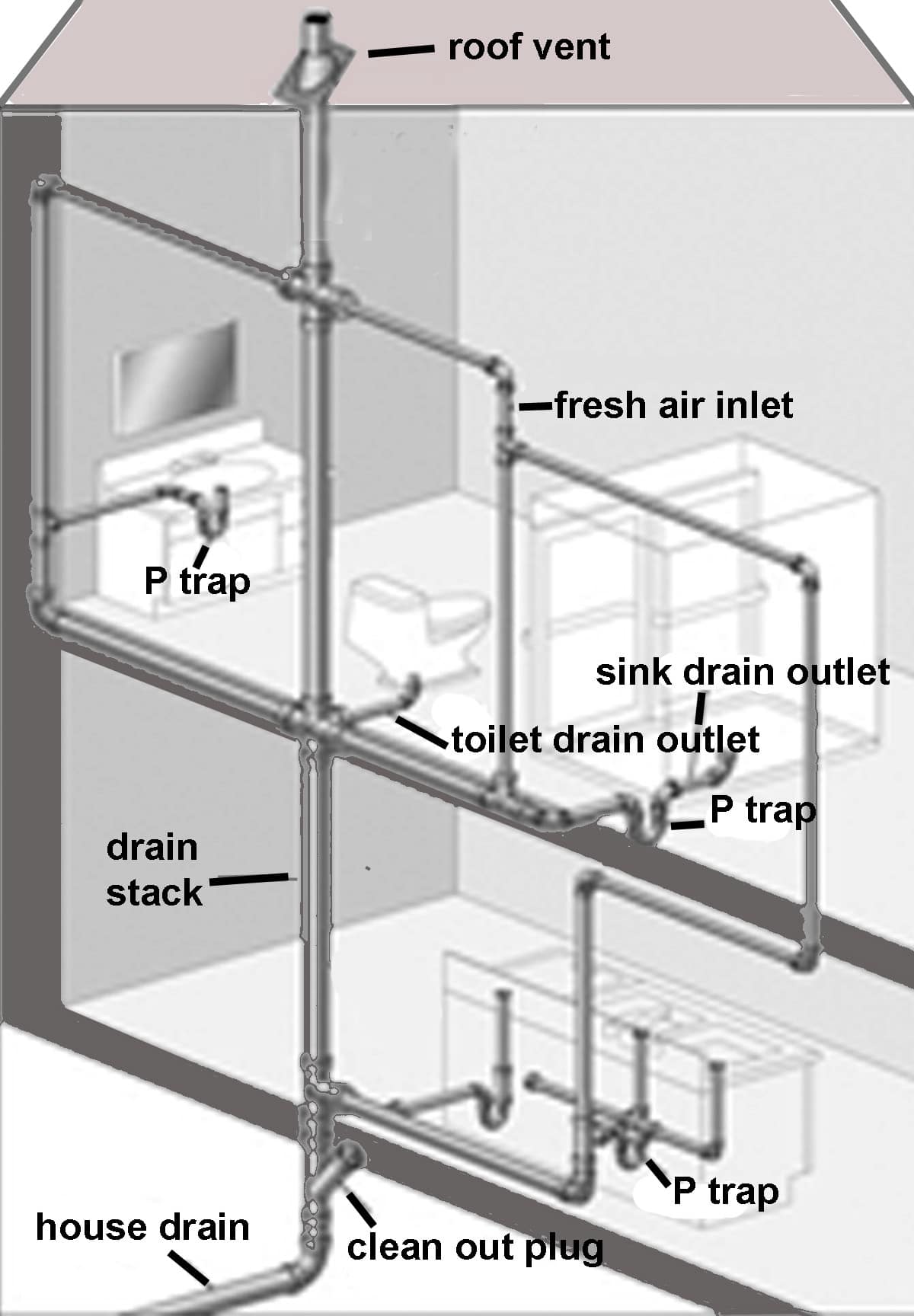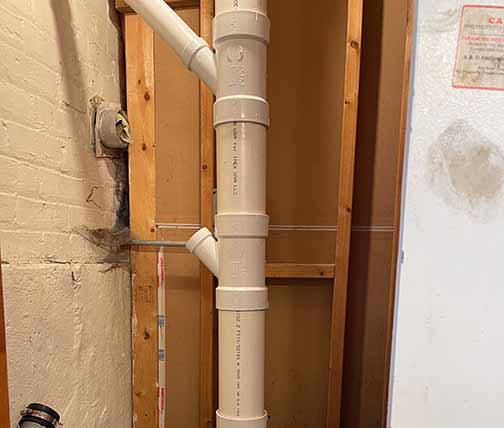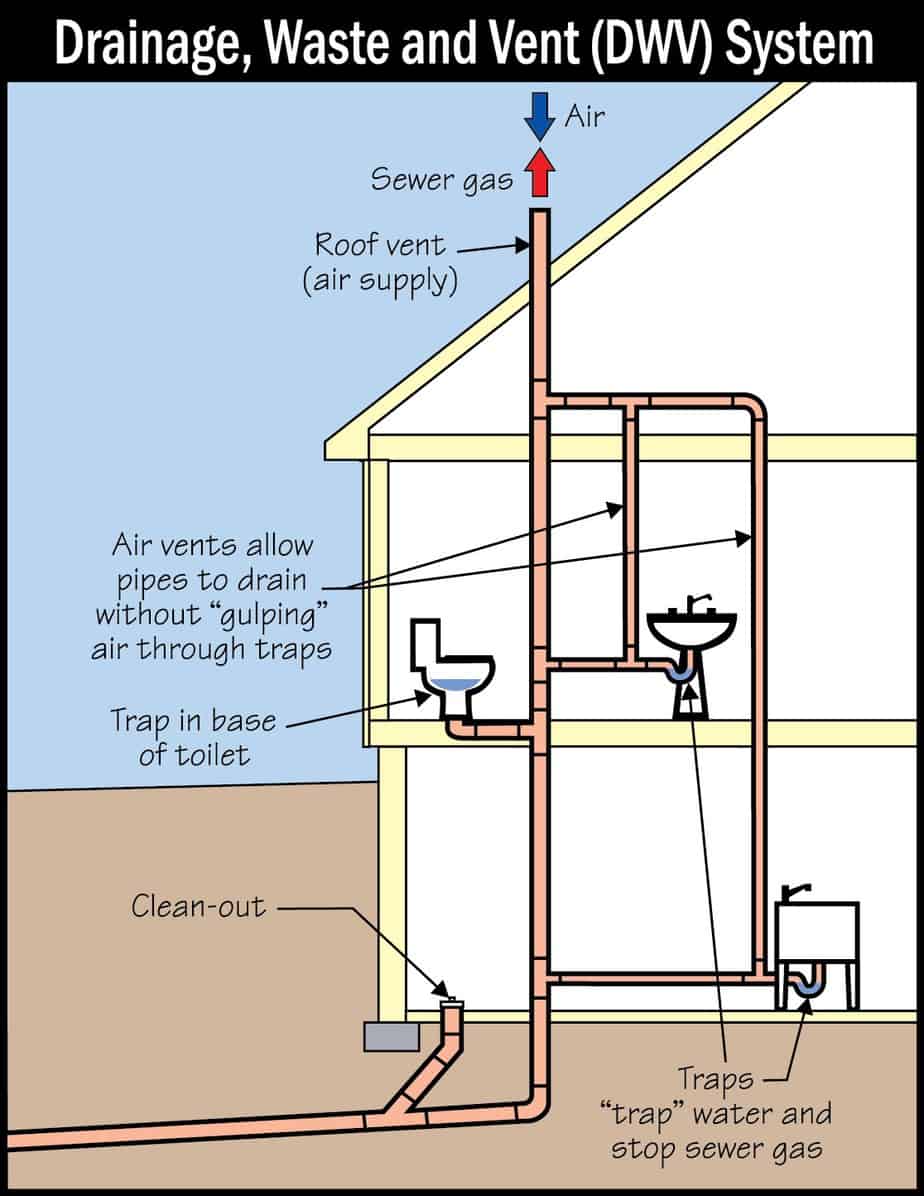Dealing with plumbing issues can be stressful. One common problem is the stack pipe issue.
A stack pipe is a key part of your home’s plumbing system. It vents sewer gases out and allows water to drain properly. When there is a problem with the stack pipe, it can cause serious issues. These issues include slow drains, bad odors, and even leaks.
Understanding the stack pipe and its problems can help you maintain a healthy plumbing system. In this post, we will explore what a stack pipe issue is, why it happens, and how to fix it. Stay with us to learn more about keeping your home’s plumbing in top shape.

Credit: www.balkandraincleaning.com
Introduction To Stack Pipe Issues
Have you ever had water drain slowly in your sink or heard strange gurgling noises from your pipes? These might be signs of stack pipe issues. In this blog post, we will dive into what stack pipes are, their importance in plumbing systems, and why it is crucial to keep them functioning properly. Let’s get started!
What Is A Stack Pipe?
Simply put, a stack pipe is a vertical pipe that carries waste water from your home’s plumbing fixtures to the sewer line. Think of it as the backbone of your plumbing system. It connects sinks, toilets, showers, and other water outlets to the main sewer line, ensuring waste water is properly drained away from your home.
Importance In Plumbing Systems
Stack pipes play a vital role in maintaining the overall health of your plumbing system. Here are a few reasons why they are important:
- Efficient Water Flow: Stack pipes ensure that water flows smoothly from your fixtures to the sewer line, preventing backups and overflows.
- Prevention of Blockages: A well-maintained stack pipe helps prevent blockages, which can cause major plumbing issues and costly repairs.
- Ventilation: Stack pipes also act as vents, allowing sewer gases to escape safely. This keeps your home free from unpleasant odors and maintains good air quality.
Imagine your plumbing system as a well-choreographed dance. Each part has its role, and the stack pipe is the lead dancer, keeping everything in harmony. Neglecting it can lead to chaos, with water backups and foul smells taking center stage.
To summarize, understanding what a stack pipe is and recognizing its importance can save you from a lot of plumbing headaches. Keep an eye out for signs of stack pipe issues and address them promptly to ensure your plumbing system remains in top shape.
Stay tuned for more tips on how to keep your plumbing system running smoothly in our upcoming blog posts!

Credit: www.chicagoplumbingexperts.com
Common Problems With Stack Pipes
Stack pipes are essential components in plumbing systems, carrying waste and water away from your home. However, they can encounter issues that, if left unchecked, could lead to bigger problems. In this section, we’ll explore some common problems with stack pipes. By understanding these issues, you can take steps to prevent them or know when to call a professional plumber.
Clogs And Blockages
One of the most common problems with stack pipes is clogs and blockages. These can occur for various reasons, such as:
- Hair and Soap Scum: Over time, hair and soap can build up in the pipes, causing blockages.
- Grease and Food Particles: Kitchen waste like grease and food can also clog pipes if they aren’t properly disposed of.
- Foreign Objects: Small objects like toys, wipes, or sanitary products can accidentally find their way into the plumbing system, leading to blockages.
To prevent clogs, consider using drain covers to catch hair and food particles, and avoid flushing non-degradable items down the toilet. If you notice slow draining or gurgling sounds, it might be time to address a potential blockage before it gets worse.
Leaks And Cracks
Leaks and cracks in stack pipes are another common issue. These can be caused by:
- Corrosion: Older pipes, especially those made of metal, can corrode over time, leading to leaks.
- Tree Roots: Roots from nearby trees can invade pipes, causing cracks and blockages.
- Temperature Changes: Extreme temperature changes can cause pipes to expand and contract, leading to cracks.
Signs of leaks include water stains on walls or ceilings, mold growth, and an unexplained increase in your water bill. Regularly inspecting your pipes and addressing any leaks quickly can prevent further damage and costly repairs.
In conclusion, being aware of the common problems with stack pipes can help you maintain your plumbing system more effectively. Whether it’s a clog or a leak, addressing these issues early can save you time, money, and a lot of headaches.
Diagnosing Stack Pipe Issues
When it comes to plumbing, diagnosing stack pipe issues can be a real head-scratcher. A stack pipe is a vital part of your home’s plumbing system, carrying waste water and air to the sewer. But what happens when things go wrong? Early diagnosis can save you a lot of trouble and money. Let’s dive into the signs of a problem and the tools and techniques you can use to get to the bottom of stack pipe issues.
Signs Of A Problem
Before you start thinking about tools and techniques, it’s important to know what you’re looking for. Here are some common signs that your stack pipe may have issues:
- Gurgling Sounds: If you hear strange noises coming from your drains, it could be air trapped in the pipes.
- Slow Drains: Water taking forever to drain? This might be a sign of a blockage in your stack pipe.
- Foul Smells: Unpleasant odors coming from your drains can indicate a break or blockage in the pipe.
- Water Backups: If water is backing up into your sinks or tubs, there’s likely a serious issue with your plumbing.
Tools And Techniques
Once you’ve identified potential symptoms, it’s time to get hands-on. Here are some tools and techniques that can help you diagnose stack pipe issues:
- Plunger: This simple tool can help dislodge minor blockages. Place it over the drain and pump it to create pressure.
- Drain Snake: A flexible, auger-like tool that can reach deep into pipes to clear out blockages. You can buy or rent one from a hardware store.
- Video Inspection: Sometimes, seeing is believing. Professional plumbers use cameras to inspect the inside of pipes and find the exact location and nature of the problem.
- Water Pressure Test: Checking the water pressure can help identify leaks or breaks in the stack pipe. If pressure drops, you’ve got an issue.
Diagnosing stack pipe issues doesn’t have to be a nightmare. With these signs and tools, you can keep your plumbing in top shape and avoid costly repairs. Remember, when in doubt, don’t hesitate to call a professional plumber. They have the expertise and equipment to handle even the trickiest plumbing problems.
Diy Solutions For Stack Pipe Problems
Dealing with stack pipe problems can be a real headache, especially when you’re not a plumbing expert. But fear not, there are some simple DIY solutions that can help you tackle minor issues on your own. Whether it’s a minor clog or a temporary leak, a little bit of know-how can go a long way. Let’s dive into a couple of practical solutions that you can easily try at home.
Clearing Minor Clogs
Minor clogs can be quite a nuisance, but they’re often easier to clear than you might think. Here are a few methods to help you get things flowing again:
- Plunger: The good old plunger is your first line of defense. Place it over the drain and give it a few firm pushes. This can often dislodge the clog and get things moving.
- Baking Soda and Vinegar: Pour half a cup of baking soda down the drain, followed by half a cup of vinegar. Let it sit for about 30 minutes, then flush with hot water. This natural solution can help break down minor clogs.
- Drain Snake: If the clog is stubborn, a drain snake can come to the rescue. Insert it into the drain and twist it to catch and pull out the blockage. It’s a bit more hands-on, but very effective.
Temporary Leak Fixes
Leaks can be alarming, but you can often manage them temporarily until a professional can take a look. Here are a couple of quick fixes:
- Pipe Tape: Wrap pipe tape around the leaky area. This can provide a temporary seal and prevent further water damage. It’s a quick and easy solution for minor leaks.
- Epoxy Putty: For a more durable fix, apply epoxy putty around the leak. This hardens and creates a strong seal. Just make sure the pipe is dry before applying it.
Remember, these DIY solutions are great for minor issues, but if the problem persists or worsens, it’s best to call in a professional plumber. After all, a stitch in time saves nine! And who wants to deal with more plumbing drama than necessary?
In conclusion, with a bit of patience and the right tools, you can handle some common stack pipe problems on your own. Just follow these simple steps, and you’ll be back to smooth sailing in no time.
When To Call A Professional
Encountering a stack pipe issue can be a homeowner’s nightmare. While some minor problems might be tackled with a plunger and a bit of elbow grease, there are instances when the expertise of a professional plumber is indispensable. Recognizing these situations early can save you from extensive damage and hefty repair bills.
Severe Blockages
If you notice that your drains are consistently slow, or if you have multiple drains clogged at the same time, it might be a sign of a severe blockage in your stack pipe. These blockages can be caused by a variety of factors, including:
- Accumulation of grease and food particles
- Foreign objects like toys or sanitary products
- Tree roots invading the pipes
Using store-bought drain cleaners can sometimes offer a temporary fix, but they often fail to address the root cause. Additionally, the chemicals in these cleaners can damage your pipes over time. A professional plumber has the tools and expertise to diagnose and resolve severe blockages effectively and safely.
Structural Damage
Stack pipes are integral to the overall plumbing system of your home. If you notice any signs of structural damage, such as leaks, cracks, or rust, it’s crucial to call a professional immediately. Ignoring these issues can lead to more severe problems, including:
- Water damage to walls, floors, and ceilings
- Mold and mildew growth
- Compromised structural integrity of your home
Imagine waking up to a collapsed ceiling or a flooded basement—definitely not the kind of surprise anyone wants! A professional plumber can assess the extent of the damage and recommend the best course of action, ensuring your home’s plumbing system remains in top shape.
In conclusion, while minor plumbing issues can often be managed with DIY solutions, severe blockages and structural damage are best left to the professionals. Their expertise can prevent small problems from becoming large disasters, saving you time, money, and stress in the long run. So, don’t hesitate—call a professional at the first sign of trouble and keep your home’s plumbing system running smoothly.
Preventative Measures
Plumbing issues can be a real headache, especially when it comes to stack pipe problems. But fear not! By taking some simple preventative measures, you can save yourself from a lot of stress and costly repairs down the line. In this section, we’ll dive into some practical steps you can take to keep your plumbing system in top-notch condition. Let’s get started!
Regular Maintenance
Think of your plumbing system like a car. Just as you wouldn’t drive your car for years without an oil change, you shouldn’t neglect your pipes. Regular maintenance is key to keeping things flowing smoothly. Here are some tips:
- Inspect your pipes: Look for any signs of leaks, rust, or damage. Early detection can prevent bigger problems.
- Clean the drains: Over time, debris and gunk can build up in your pipes. Use a mixture of baking soda and vinegar to keep them clean.
- Schedule professional check-ups: Have a plumber inspect your system annually. They can spot issues that you might miss.
Proper Use Of Drains
How you use your drains plays a huge role in preventing plumbing issues. Treat them well, and they’ll treat you well in return. Here’s what you should do:
- Don’t pour grease down the drain: It might be liquid when hot, but it solidifies as it cools. This can cause clogs.
- Use drain covers: These can catch hair and other debris, preventing them from going down the drain and causing blockages.
- Dispose of food scraps properly: Instead of rinsing food scraps down the sink, throw them in the trash or compost.
- Be mindful of what you flush: Only flush toilet paper and human waste. Other items can cause serious blockages.
By following these simple yet effective tips, you can keep your plumbing system in good shape and avoid those dreaded stack pipe issues. Remember, a little prevention goes a long way!
Cost Considerations
Dealing with a stack pipe issue can be stressful. Knowing the costs involved is crucial. Let’s break down these costs and see what factors to consider.
Diy Vs. Professional Services
Choosing between DIY and professional services affects your budget. DIY can save you money upfront. You only need to buy materials. However, it requires time and effort. Mistakes can lead to higher costs later.
Professional services are more expensive initially. Plumbers charge for their expertise. They ensure the job is done correctly. This can prevent future issues and save money in the long run.
Long-term Savings
Fixing stack pipe issues promptly saves money over time. Ignoring the problem can lead to serious damage. Water leaks can cause mold and structural damage. These are costly to repair.
Professional repairs often come with a warranty. This provides peace of mind. If a problem recurs, the plumber will fix it at no extra cost.
Investing in quality repairs now prevents bigger expenses later. It’s a smart financial decision. Always consider long-term savings when addressing plumbing issues.

Credit: everestmechanical.com
Frequently Asked Questions
What Happens If A Plumbing Stack Is Clogged?
A clogged plumbing stack can cause slow drains, gurgling noises, sewage backups, and unpleasant odors in your home.
How Much Does It Cost To Replace A Stack Pipe?
Replacing a stack pipe typically costs between $1,000 and $4,000. Prices vary based on materials and labor.
What Is A Stack Pipe In Plumbing?
A stack pipe in plumbing is a vertical pipe that carries waste water from fixtures to the sewer line. It ensures proper drainage and venting.
When Should I Replace My Plumbing Stack?
Replace your plumbing stack if you notice frequent clogs, leaks, or corrosion. Upgrading after 50 years is advisable.
Conclusion
Fixing a stack pipe issue is essential for a healthy home. Regular checks prevent costly repairs. Always address leaks quickly. Professional help ensures long-term solutions. Keep your plumbing efficient and trouble-free. Understand your plumbing system better. Stay proactive to avoid future problems.
Happy plumbing!
